We plant raspberries in the spring correctly
Everyone knows that raspberries are a delicious berry, which literally beckons with its appearance, unique aroma, and unsurpassed taste, which means that almost all novice summer residents want to plant a neat raspberry tree on their backyard.
To successfully plant raspberries in the spring, you first need to decide on the variety and timing, choose a suitable place on the site and planting method, and then prepare the planting holes or a trench, where to plant the seedlings. Read on how to do this correctly.
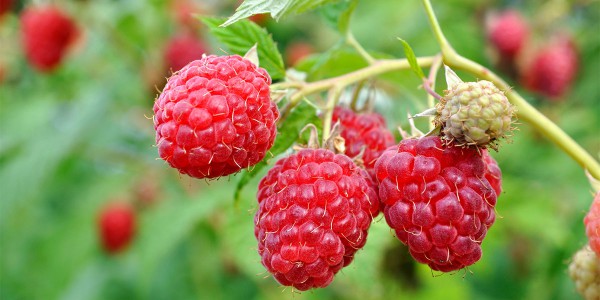
Content
- 1 When to plant raspberries in the spring, in what month: optimal timing
- 2 Raspberry planting methods: preparation of planting holes and trenches
- 3 How to plant raspberries in the spring in a planting hole or trench
- 4 Further care for raspberries after spring planting
- 5 Possible mistakes when planting raspberries in spring
When to plant raspberries in the spring, in what month: optimal timing
You can start planting raspberries as soon as the last snow melts and a stable positive temperature is established.
Raspberries are not afraid of small frosts, so they can easily endure recurrent spring frosts.
The planting of the seedlings itself must be carried out before the buds bloom, in other words, before the active sap flow begins.
Although, if you bought a seedling in a container, so to speak with a closed root system, it can be planted later, when it has foliage.
As for certain dates, depending on the climatic conditions of your region, raspberries are planted at the end of March - April.
When is it better to plant - in spring or autumn
Some gardeners find it best to plant raspberries in the fall, when the plant is already asleep.
However, it is impossible to give an unequivocal answer when it is better to plant raspberries - in autumn or spring. Therefore, each gardener decides on his own when it is more convenient for him to plant raspberries, so to speak, as needed and with free time.
Important! More details about planting raspberries in autumn read in this article.
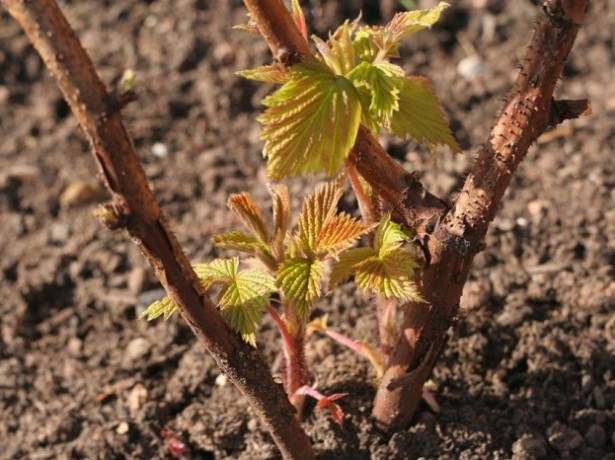
Planting dates in spring in different regions
Naturally, depending on climatic features, the timing of spring planting of raspberries in different regions is different:
- In the South of Russia, you can plant raspberries in March or early April.
- Gardeners of the Middle Strip and the Moscow Region should plant raspberries no earlier than April.
- In Siberia and the Urals, it is possible to plant raspberries in open ground only in late April-early May.
According to the lunar calendar in 2020
Choose the optimal date for planting seedlings can help you moon calendar.
So, favorable days for spring planting of raspberries in 2020, according to the lunar calendar, are:
- in March - 26-29;
- in April - 11-15, 24, 25;
- in May - 2-10.
Of course, it is not always possible to get to the dacha on these days, so the main thing is not to land on unfavorable dates (the days of the Full Moon and New Moon, as well as the period when the Moon is in Aquarius, since this is a barren and dry sign -italicized).
Unfavorable days, according to the lunar calendar, for 2020 for planting raspberry seedlings in spring, the following dates are:
- in March - 9,19-21, 24;
- in April - 8,15-17, 23;
- in May - 7,13-14, 22;
- in June - 5,9-11, 21.
According to the lunar calendar, from the magazine "1000 Tips for Summer Residents".
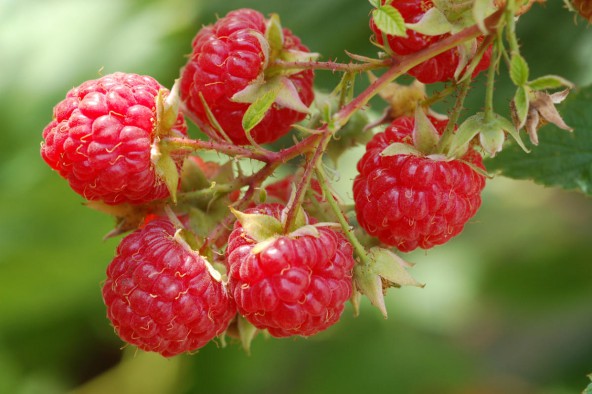
Raspberry planting methods: preparation of planting holes and trenches
Typically, the choice of planting method depends on the type of soil in your area.
If sandy soil, in other words, the water leaves very quickly, the raspberries will constantly need moisture. Therefore, in this case, they dig trench and fill it with fertile soil that retains moisture well.
Note! However, often raspberries are planted in trenches simply because it is much more convenient and faster to make a raspberry plantation, and not because of the type of soil.
On the contrary, if the soil you heavy and clayey, then it is better to plant raspberries on high beds (15-20 cm).
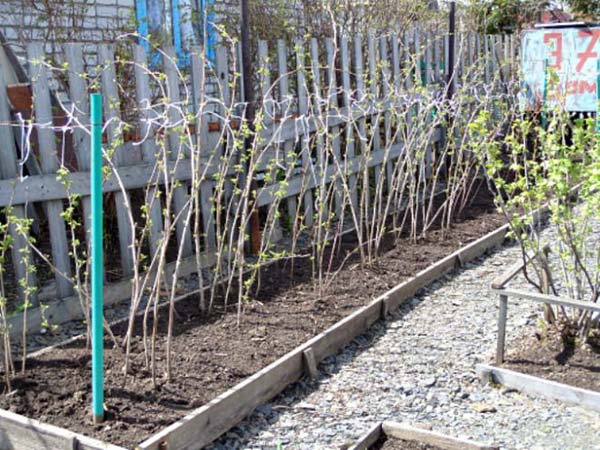
However, most often raspberries are planted in ordinary planting pits (bush method).
For planting raspberries in any of the ways, it is first prepared and cleared of weeds selectedplot, and at least 2 weeks before planting seedlings.
Landing in a hole (bush method)
- With the bush method of planting raspberries, you need to dig a hole: 30-40 cm deep, 30-40 cm wide and also long.
- Next, pour half a bucket-bucket of humus mixed with phosphoric and potash fertilizers.
For your choice:
Mineral fertilizers: superphosphate (50-80 grams) and potassium sulfate (30-50 grams).
Organic fertilizers: bone meal (100-200 gr), wood ash (100-200 gr).
- Then add fertile soil mixed with humus (2 to 1).
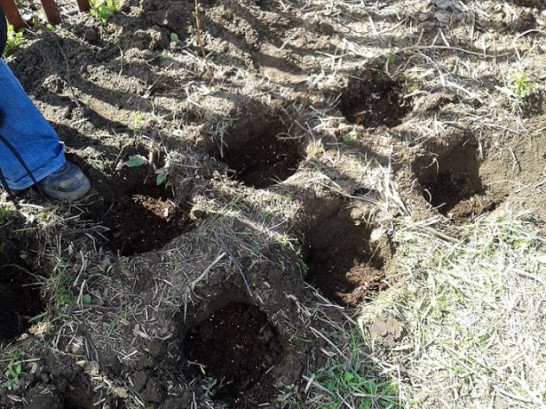
- Plant a seedling.
Trench method
First of all, the trench itself should be correctly placed, namely, dug from south to north (or from north to south) so that the eastern part is illuminated in the morning, and the western part from the second half. Thus, the plant will develop evenly and receive adequate lighting for normal vegetation and photosynthesis processes.
When digging a trench, it is very convenient to fold the upper fertile layer on one side of the trench (in the future it will be required), and the deep one on the other (we will no longer need it).
The optimal size of the trench for planting raspberries is 40 in width and 40 cm in depth (sometimes up to 50 cm), and in length - as necessary and possible.
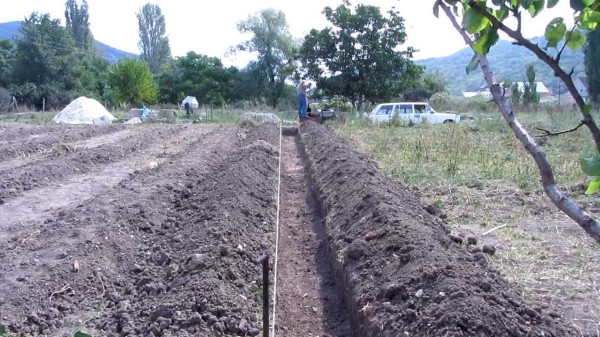
Next, you need to correctly fill the trench:
If you see that the ground is dry, then first you should carry out moisture-charging irrigation.
- 1st layer (15-20 cm). Pour humus on the bottom of the pit (2-3 buckets per running meter).
Important! Sometimes it is advised to lay slightly rotten twigs and pieces of wood at the bottom of the pit, and also pour the mowed grass on top. However, you need to know that when they rot, your seedling can take and go underground, while the root collar will be buried, which should not be allowed.
- 2nd layer (20-25 cm). Then sprinkle on top phosphoric and potash fertilizers. Optionally, they can be dug up with 1 layer of humus.
Of your choice;
Mineral fertilizers: superphosphate (90-120 grams per running meter) and potassium sulfate (60-90 grams per running meter).
Organic fertilizers: bone meal (200-400 gr), wood ash (200-400 gr).
- 3rd layer. This will be the top fertile soil layer with humus (2 to 1).
- Plant seedlings.
Video: planting raspberries in a trench way (1st and 2nd part).
How to plant raspberries in the spring in a planting hole or trench
Before planting seedlings, you first need to decide on a suitable place on the site. It also does not hurt to learn about the basic rules for placing raspberries and choose a planting method. And, of course, choose high quality seedlings.
What should be a seedling
When choosing a seedling, you should pay attention to its root system, it must be well developed.
A high-quality seedling has a developed fibrous system, 10-15 cm long.
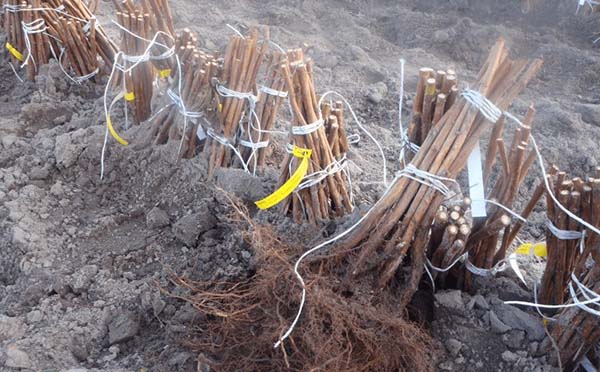
Advice! If you are planting raspberries for the first time, then it is better to purchase seedlings with a closed root system, that is, at least in the ground, and preferably in pots.
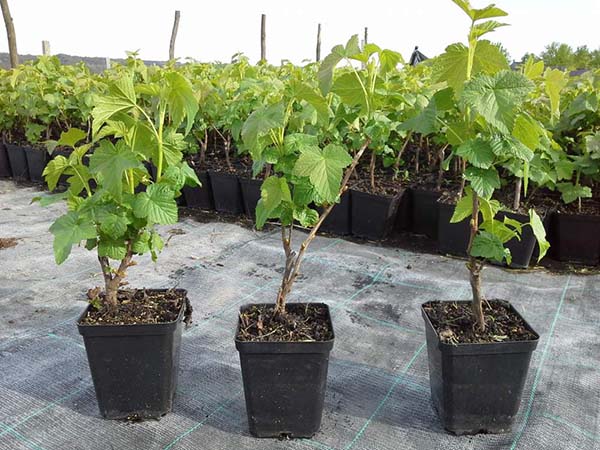
If you have purchased seedlings with an open root system, then immediately before planting, carefully inspect the roots of the seedlings, cut off all dry and rotten parts, and then dip them in a clay mash.
Landing place
For planting raspberries, it is recommended to choose a place in advance. It should be open and sunny, but closed on the north side from drafts and cold winds.
If during the day the raspberries are in shade for a long time, the ripening dates may shift to later ones. For the same remontant raspberry, this is very bad, because the berry may simply not have time to ripen.
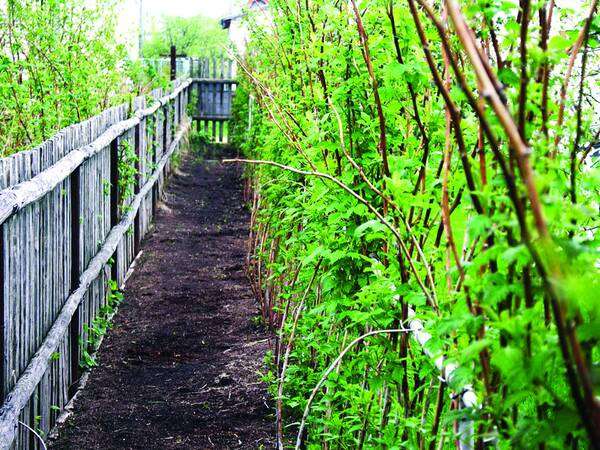
Raspberries, although they love abundant watering, do not tolerate prolonged stagnation of moisture. Therefore, you cannot plant a shrub if the groundwater is closer than 1 meter.
You cannot plant raspberries in a place where raspberries also grew earlier. The fact is that spores of fungal diseases and larvae of pests could remain in the soil.
Also, raspberries are not planted after strawberries, because they have one common pest - raspberry-strawberry weevil.
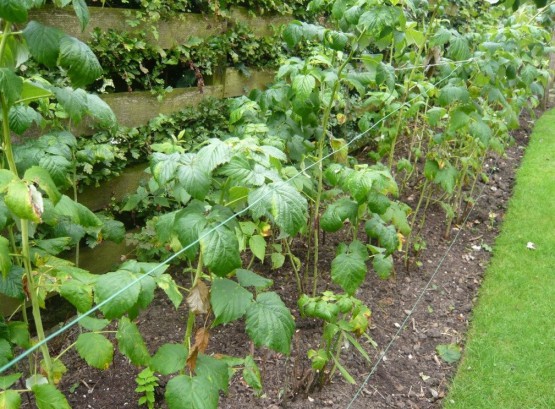
What soil is needed
Raspberries are very fond of fertile land.
However, you can grow it both on sandy soils and on clayey, although, of course, ideally it should be loamy or sandy loam soil.
In any case, on poor soils, you will hardly be able to get a rich harvest of raspberries, therefore, when planting, depending on the fertility of your land, you must definitely apply mineral and organic fertilizers.
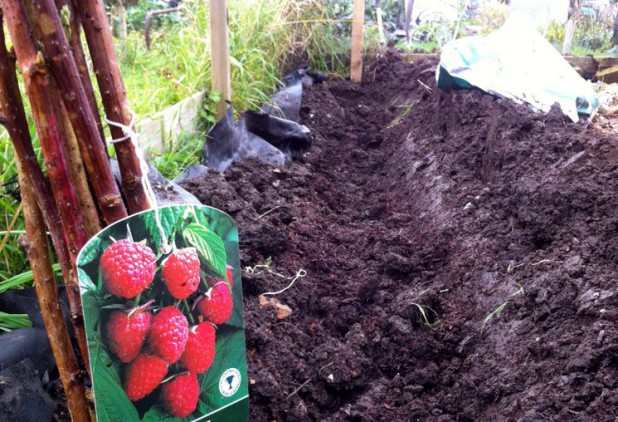
The optimum soil acidity for successful cultivation of raspberries is 5.5-6.5 pH (slightly acidic-neutral).
On alkaline or acidified soils, raspberries will just sit, and not develop and bear fruit.
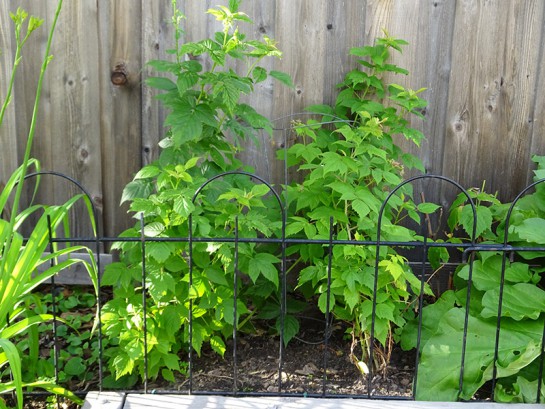
Distance between bushes and rows
Raspberries are planted in such a way that a distance of 50-80 cm remains between the bushes (depending on which variety is vigorous or not), and in the aisles - 1.2-2 meters.
This distance allows you to conveniently harvest and take care of the berry bushes. In addition, plants planted at such a distance do not interfere with each other, and they have enough nutrition.
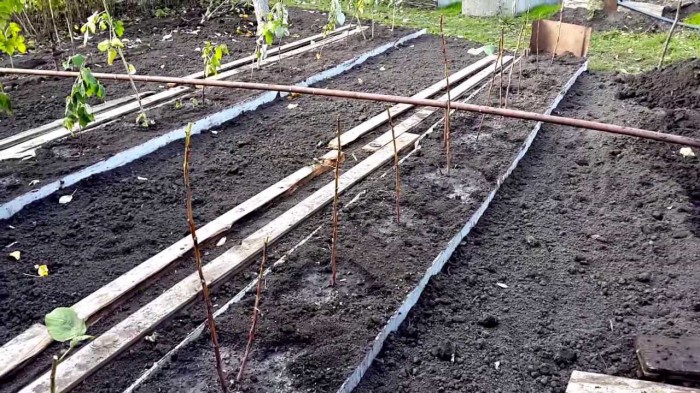
Landing hole and planting depth
As a rule, a hole 40-50 cm deep is dug for planting raspberries.At the same time, its width and length, as a rule, are also the same 40-50 cm. These dimensions of the planting hole allow you to make all the necessary organic and mineral fertilizers required for active growth and abundant fruiting of the berry bush.
The very same planting of the seedling is carried out so that the root collar (replacement buds) is eventually at the soil level.
Direct landing
Step-by-step instructions for planting raspberries in spring:
- Place the seedling in the center of the planting hole or trench on a small mound, and then gently and evenly spread its roots.
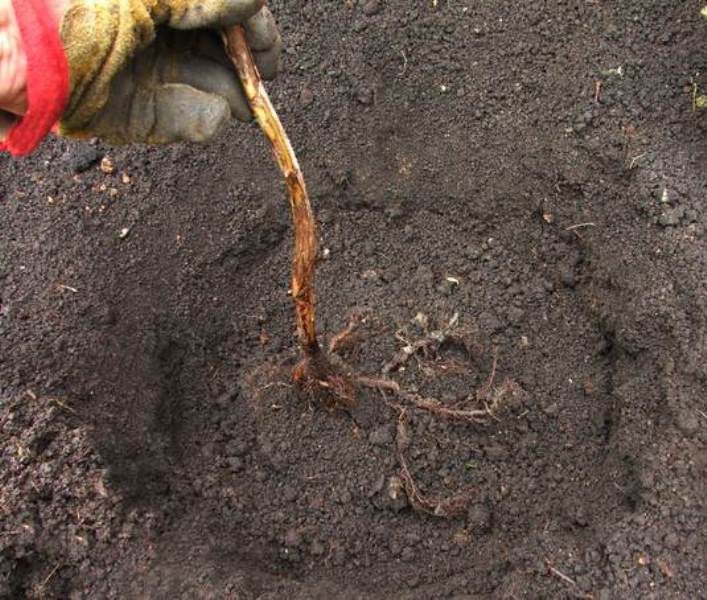
Interesting! Some experts recommend planting raspberry seedlings with an open root system directly into the slurry, in other words, you must first spill a hole or trench abundantly with water. You can try it like that.
- Sprinkle with fertile garden soil mixed with humus (2 to 1).
Falling asleep with soil, it is recommended to slightly raise the seedling several times so that the roots come into better contact with the soil and no voids form around them.
As a result, the root collar (replacement buds) should be at the soil level.
- Compact the soil around the seedling.
- Spill abundantly with water (5-10 liters) to ensure maximum contact between roots and soil.
- Landing is complete, but there are a couple of nuances left, which will be discussed later.
Video: planting raspberries in spring
Are there any differences in planting and caring for remontant raspberries
The whole difference between remontant and regular raspberries is that remontant raspberries can bear fruit both on the shoots of the current year and the past, i.e. instead of one harvest, you can get two (1 time - in June-July, 2 times - in August-September).
However, it is worth knowing that the second (autumn) harvest of remontant raspberries is less tasty, while the first (summer) harvest is not inferior to the usual one.
Nevertheless, it makes sense to have both regular and remontant varieties on the site in order to collect tasty and healthy berries in summer and autumn.
Naturally, remontant raspberries are more demanding on light, watering and feeding than ordinary ones, which is quite logically explained by its greater fertility.
Video: features of planting and caring for remontant raspberries
Further care for raspberries after spring planting
So, here you are and have planted raspberry seedlings. What to do next? How to care for them after landing?
Immediately after landing, it is mandatory trim raspberry seedlings up to a height of 15-25 cm, if they have not yet been cut by the seller in advance (as a rule, they sell or send just such).
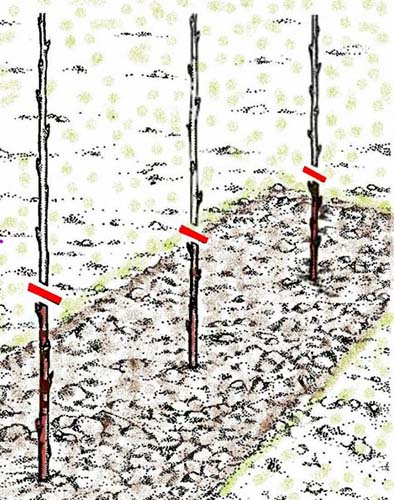
If this is not done, then the raspberry will spend a lot of energy on the leaves and buds that form on a high stem, which will greatly deplete its already weak roots. As a result, the seedling will noticeably lag behind in development: it simply does not form a good root system and a sufficient number of replacement buds (from which shoots should appear next year).
Further it is highly desirable mulch near-trunk circle of raspberry seedlings. Mowed grass, hay, straw or rotted sawdust are perfect for this.
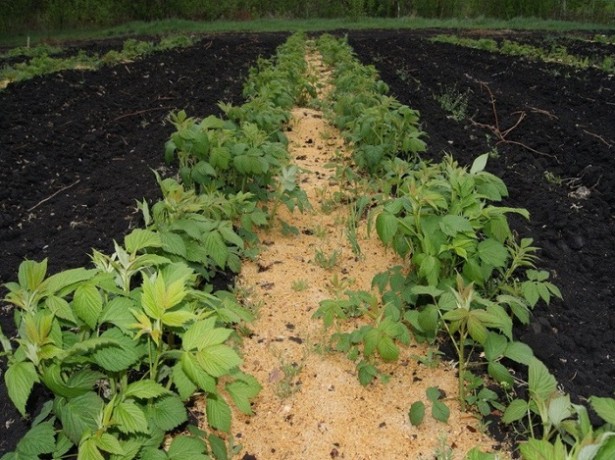
What is it (mulching) for:
- After abundant watering, a dry crust often forms. Thanks to mulch, the soil will always be loose and moisture will last longer.
- Weeds, which raspberries do not like so much, will not grow under the mulch.
- Mulch is an excellent organic food supplement.
- Of course, we must not forget about watering.
Any raspberry is very fond of watering (especially remontant), and it is necessary to water very abundantly.
- No additional fertilizing will be required in the next 2-3 years, of course, if you have applied a sufficient amount of nutrient soil and fertilizers to the planting pits before planting.
- And in the fall you will need prepare the bushes for winter.
Advice! How to care for raspberries in the fall and properly prepare them for winter is detailed in this article.
Later in the composition basic raspberry care activities will include the following:
- Annual pruning after fruiting (in autumn) or in early spring.
Basic trimming raspberries perform, as a rule, after fruiting (in autumn), and in the spring they do only corrective, or rather sanitary pruning.
Of course, if you have not had the opportunity to prune raspberries in the fall, then pruning in the spring is better than not pruning at all.
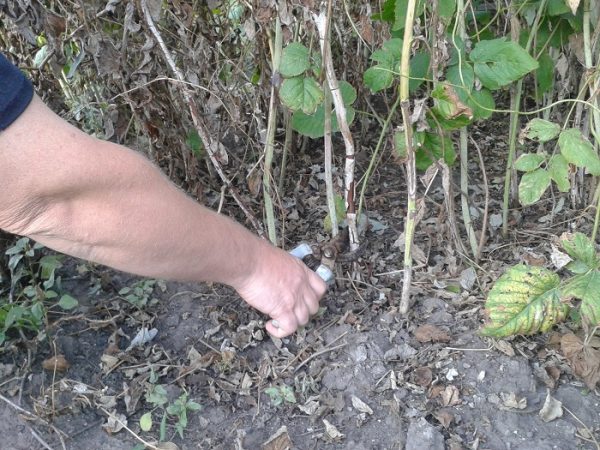
- garter shoots;
By the way! About, how to tie up raspberries in spring and autumn, you can read in this material.
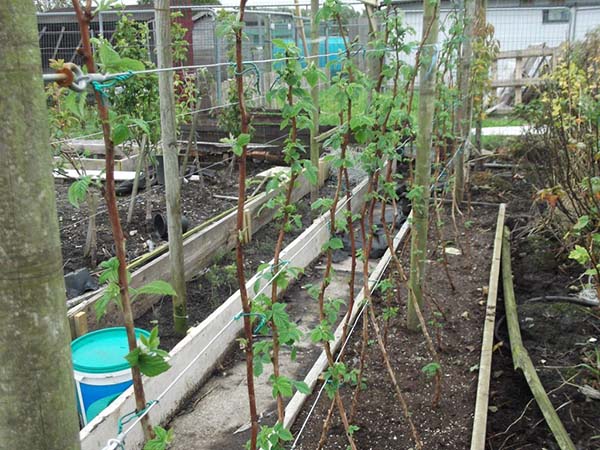
- fertilization;
Advice! The site already has detailed materials about spring feeding raspberriesand also about autumn.
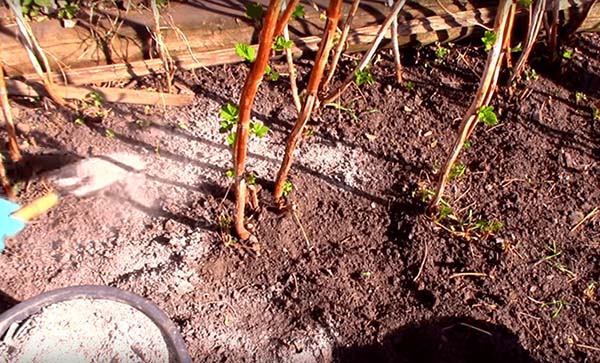
- treatment for diseases and pests.
Important! About, what and how to spray raspberries in the spring, written in detail in this article.
- If the raspberries are too big then it should be mandatory plant and transplant.
By the way! How to do it right in spring, summer or autumn, read here.
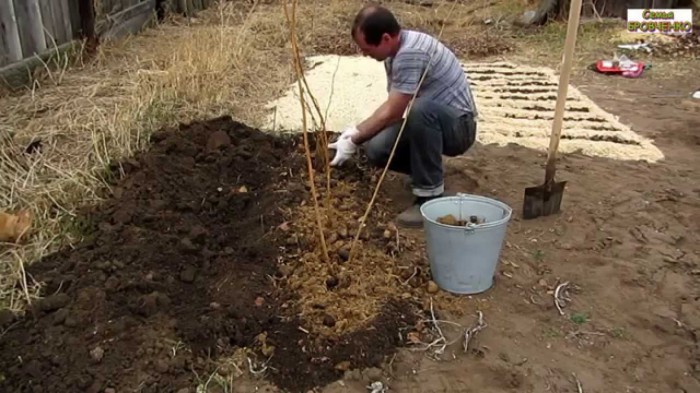
How to limit the reproduction and spread of shrubs on the site during planting, so that later you do not suffer
Very simple. If you want to limit the growth of raspberries, then in the aisles you should bury sheets of slate, old roofing iron or similar material to a depth of 40-50 centimeters.
Alternatively, you can make a warm bed with a slate fence.
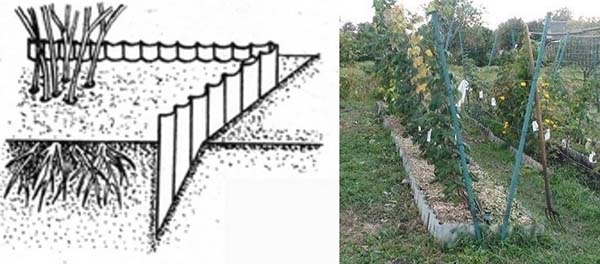
Possible mistakes when planting raspberries in spring
Many novice gardeners start planting raspberries without knowing some of the nuances, so they often make annoying mistakes.
In order to properly plant raspberries and the plant quickly took root, and then went into active growth, you need to exclude the following popular mistakes:
- Initially purchased poor quality seedling.
- Are selected wrong landing dates - either too early (the ground is frozen), or too late (in the summer, when it is already hot).
- Picks up too shaded place.
- Crop rotation rules are not followed (Raspberries should not be planted where raspberries and strawberries used to grow).
- Necessity is ignored making a sufficient amount of nutrient soil and fertilizers into planting holes or trenches.
- Bushes are planted too close to each other... Strong thickened plantings poorly ventilated, causing the plants to hurt. Or, as a result of a lack of sunlight and nutrients, too small berries are tied.
- Overly deepens when landing root collar.
- After landing no trimming.
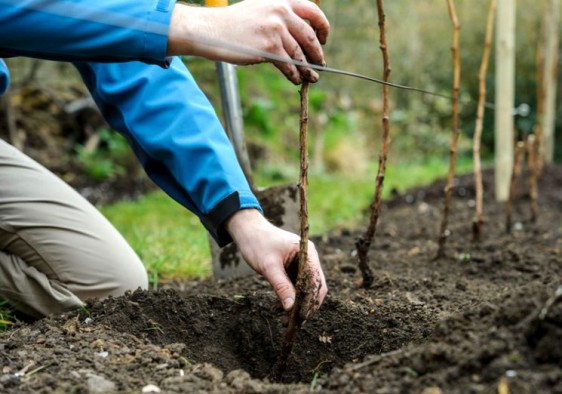
Thus, there is nothing difficult in planting raspberries in the spring. You just need to buy good seedlings, choose a suitable place in the garden, prepare a planting hole (choose a planting method) and plant it correctly. And then remember to prune, mulch and water abundantly for the rest of the season.
Video: features of planting raspberries


WHAT TO DO? CAN PLANT RASPBERRY ONLY THERE. WHERE THE RASPBERRY IS ALREADY, BUT GIVES A WEAK AND SMALL HARVEST. THERE IS NO OTHER PLACE. HOW TO GET IT PRESENT ... 🙏
It is imperative to apply all the necessary fertilizers for digging, including mineral fertilizers (superphosphate is required) and more humus (rotted manure)! And during the growing season (before and after flowering) - more potassium fertilizers (potassium sulfate or wood ash) and the harvest will be good 🙂